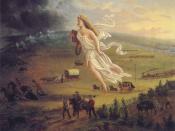More than a century after the American Indian civilization and culture was systematically conquered and destroyed, Dee Brown published his historical commentary on the plight of these people. Focused primarily on the thirty-year period from 1860 to 1890, it was the first book written on this subject from the perspective of the American Indian by a white author. Because of the pervading belief in the imperialistic theory, Manifest Destiny, the U.S. government engaged in a methodical process of threats, deceptions, and murder to acquire American Indian land and eradicate American Indian beliefs and practices. From Brown's perspective, the Americans instigated the majority of the conflict and caused the rivalry between the two opposing groups.
Dee Brown grew up in Arkansas where he developed his interest in the Indians. After befriending many American Indians in his youth, he no longer believed the popular description of the Indians as a savage people.
He spent time as a reporter, a teacher, and a librarian, and eventually obtained a master's degree in library science. He began writing Bury My Heart at Wounded Knee in the late 1960s and published it in 1970. It has since sold more than five million copies around the world. Following its publication, the book was generally well received by critics and popular readers. It was described by the New York Times as "a grim, revisionist tale of the ruthless mistreatment and eventual displacement of the Indian by white conquerors from 1860-1890." He has been criticized by professional historians for his lack of attention to specific historical fact and detail in lieu of borderline propaganda to excite the story.
Bury My Heart at Wounded Knee is divided into nineteen chapters, each generally dealing with a separate tribe. It begins with the tribes of the southwest, detailing, as the book progresses,


